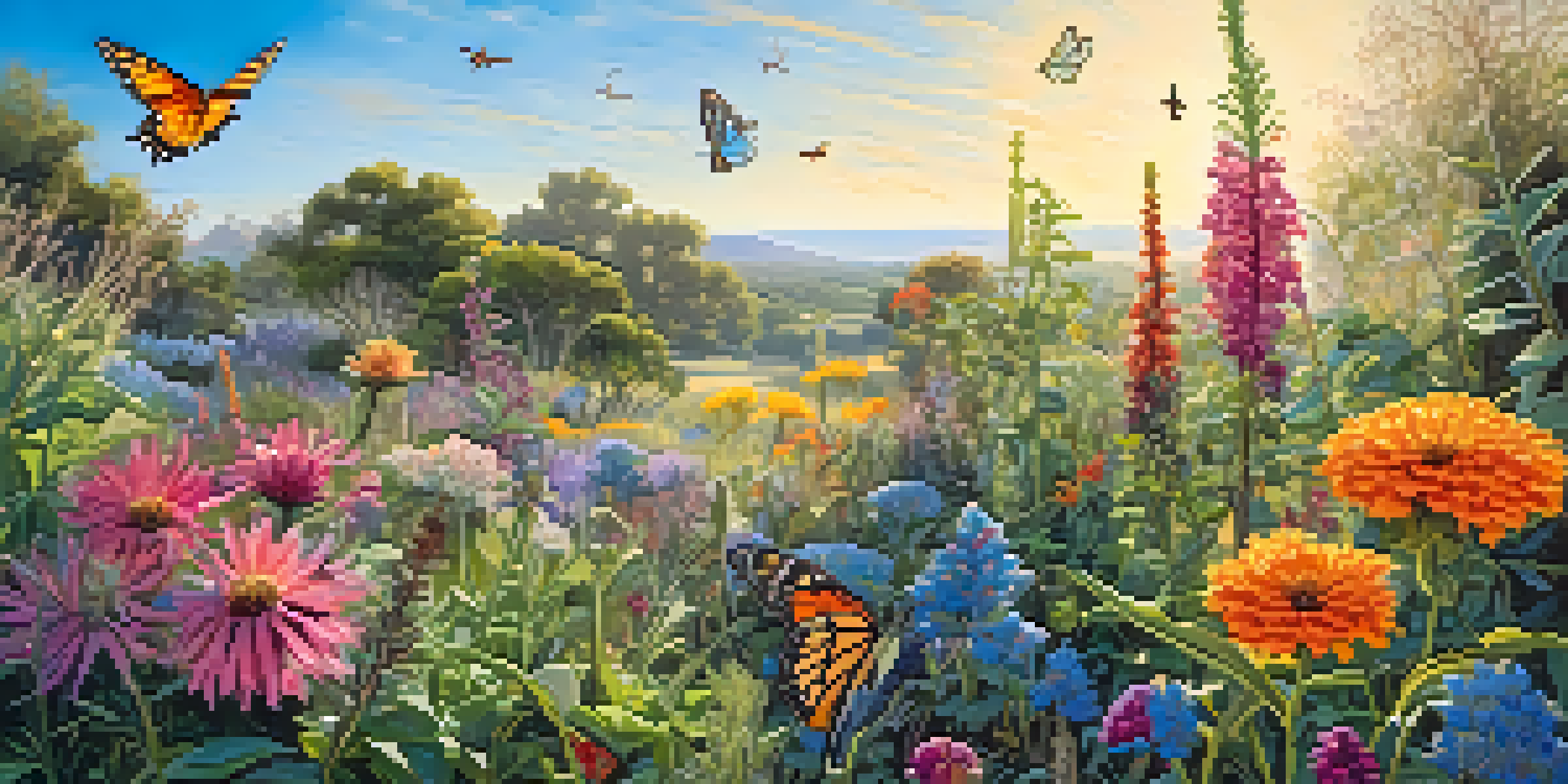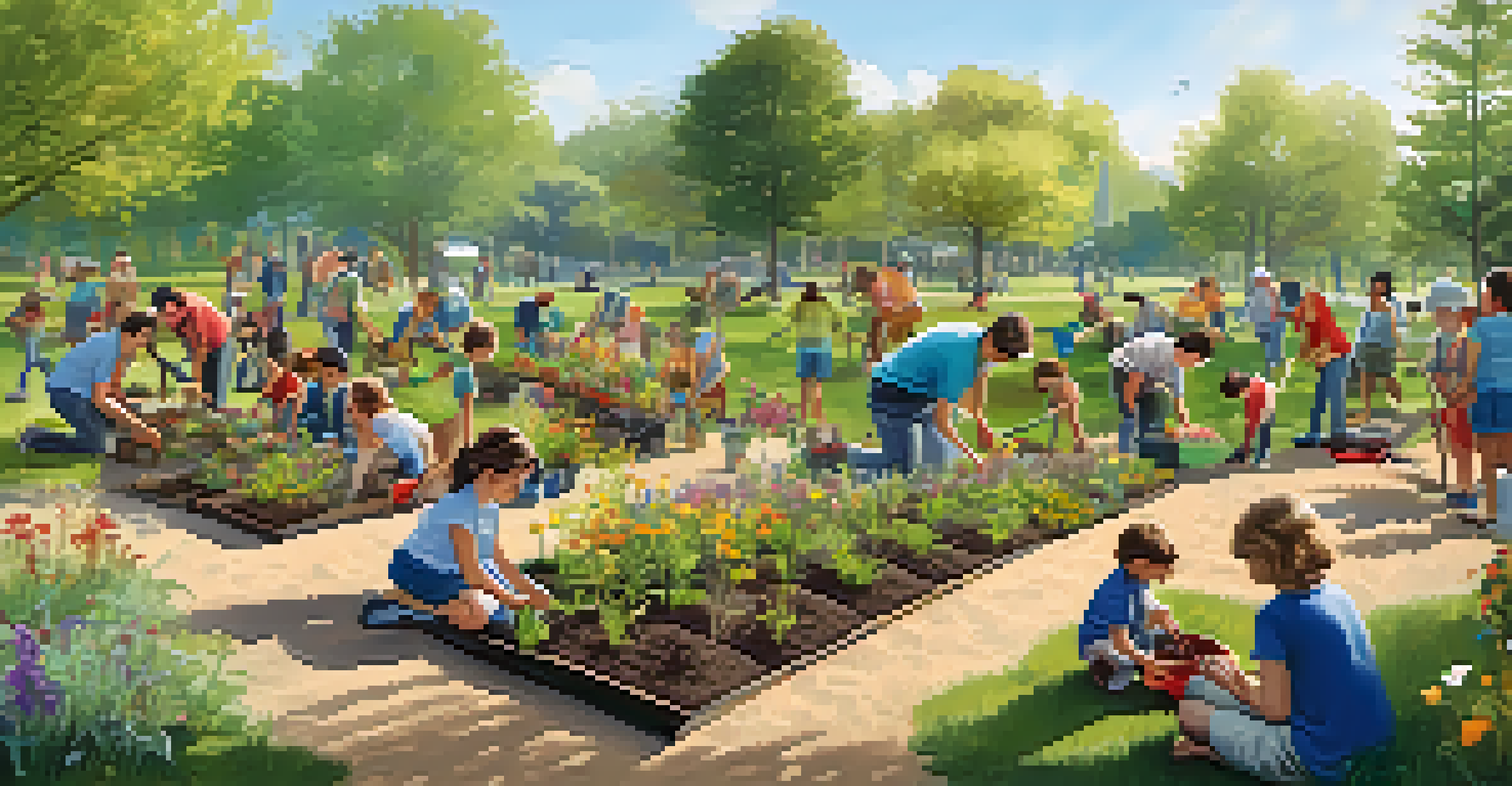Creating Biodiverse Landscapes: A Sustainable Approach

Understanding Biodiversity and Its Importance
Biodiversity refers to the variety of life forms in a given ecosystem, encompassing everything from plants and animals to microorganisms. It's crucial for maintaining the balance of our ecosystems, providing essential services such as pollination, nutrient cycling, and climate regulation. Without robust biodiversity, our natural environments can become unstable, leading to challenges like crop failure or increased disease prevalence.
Biodiversity is not a luxury; it is a necessity for life.
Imagine a thriving garden filled with various plants, insects, and birds. Each species plays a role, contributing to a vibrant ecosystem that supports one another. When we prioritize biodiversity, we create landscapes that not only look beautiful but also function effectively, providing habitats for wildlife and resources for humans.
Incorporating biodiversity into our landscapes means recognizing the interconnectedness of all life. This approach can lead to healthier ecosystems, which in turn enhances our quality of life. As we delve deeper into creating biodiverse landscapes, we’ll see how sustainable practices can foster this rich tapestry of life.
Key Principles of Designing Biodiverse Landscapes
Creating biodiverse landscapes starts with understanding key design principles, such as native planting, habitat connectivity, and ecological resilience. Native plants are adapted to local conditions and provide food and shelter for local wildlife. By incorporating these species, we can create a more balanced ecosystem that requires less maintenance and resources, making it a sustainable choice.

Habitat connectivity is another vital principle. Think of it like building a highway for wildlife; by ensuring that different habitats are linked, we allow animals to move freely, find food, mate, and avoid predators. This connectivity helps maintain genetic diversity and supports thriving populations of various species.
Biodiversity Enhances Ecosystem Health
Diverse ecosystems provide essential services like pollination and climate regulation, contributing to a stable environment.
Lastly, ecological resilience refers to the ability of an ecosystem to recover from disturbances. By designing landscapes that incorporate diverse species, we can create systems that are better equipped to withstand challenges such as climate change or invasive species. These principles guide us in crafting spaces that not only support biodiversity but also promote sustainability.
Choosing Native Plants for Your Landscape
When selecting plants for a biodiverse landscape, native species should be your first choice. These plants are naturally suited to the local climate and soil conditions, which means they require less water and fewer chemicals to thrive. Plus, they often provide the best resources for local wildlife, such as nectar for pollinators or seeds for birds.
The future will be shaped by how we care for our environment today.
For example, if you live in a region where wildflowers bloom, incorporating these plants can attract bees and butterflies, essential for pollination. Not only do these native plants enhance the beauty of your landscape, but they also support the local ecosystem by providing food and habitat for various species.
Don't be afraid to think outside the box when it comes to native plants. By mixing different types and layers—like grasses, shrubs, and trees—you can create a rich tapestry that resembles a natural ecosystem. This diversity not only looks appealing but also boosts the overall health and resilience of your landscape.
Creating Habitat Corridors for Wildlife
Habitat corridors are essential for promoting biodiversity in urban and rural landscapes. These corridors connect isolated habitats, allowing wildlife to move freely between them. Think of it as a natural highway that enables animals to find resources, mates, and shelter without facing barriers like roads or buildings.
When designing your landscape, consider incorporating features such as hedgerows, green roofs, or even small ponds that serve as stepping stones for wildlife. These features can greatly enhance the connectivity of your landscape, making it more hospitable for a variety of species. The more connected the habitats, the healthier the populations of plants and animals.
Native Plants Foster Local Wildlife
Incorporating native species into landscapes not only supports local wildlife but also requires less maintenance and resources.
Creating these corridors not only benefits wildlife but also enriches our experience of nature. Imagine walking through a landscape filled with birds singing, butterflies flitting, and the scent of blooming flowers. By fostering these connections, we can create vibrant ecosystems that thrive alongside human communities.
Implementing Sustainable Practices in Landscape Management
Sustainable landscape management practices are crucial for maintaining biodiversity over time. This includes strategies such as organic gardening, mulching, and using rainwater harvesting systems. These practices help minimize environmental impact while promoting a healthy ecosystem.
For instance, organic gardening avoids harmful pesticides and fertilizers, making it safer for both wildlife and humans. Instead, we can use natural alternatives like compost or beneficial insects to keep pests in check. This not only protects biodiversity but also helps create a more resilient landscape that can withstand pests naturally.
Additionally, implementing water-efficient practices like rain gardens or drip irrigation can help conserve water while supporting local flora and fauna. By adopting these sustainable methods, we not only enhance our landscapes but also contribute to a healthier planet for future generations.
The Role of Community in Biodiverse Landscapes
Community involvement is key to creating and maintaining biodiverse landscapes. When local residents engage in the planning and care of their green spaces, they become more invested in their health and sustainability. This collective effort can lead to more vibrant, diverse ecosystems that reflect the unique characteristics of the area.
Consider organizing community planting days or workshops on native gardening techniques. These events not only educate people about the importance of biodiversity but also foster a sense of ownership and pride in the local environment. When everyone contributes, the landscape flourishes, and wildlife benefits.
Community Involvement Boosts Biodiversity
Engaging local residents in the care of green spaces leads to healthier, more vibrant ecosystems that reflect community values.
Moreover, community engagement can extend beyond individual gardens. By collaborating with local organizations, schools, and government bodies, we can develop larger initiatives that promote biodiversity on a grander scale. Together, we can create a network of biodiverse landscapes that enhance the overall health of our communities.
Measuring Success in Biodiversity Efforts
To ensure that our efforts in creating biodiverse landscapes are successful, we must measure and monitor their impact. This can involve assessing species diversity, plant health, and the presence of wildlife over time. By tracking these indicators, we can identify areas that need improvement or adjustments.
For example, setting up wildlife cameras or conducting plant surveys can provide valuable data on how well our landscapes are supporting biodiversity. If certain species are thriving, it’s a sign that our practices are working. Conversely, if we notice a decline, we can reevaluate our strategies and make necessary changes.

Regularly measuring success not only helps us improve our landscapes but also demonstrates the tangible benefits of our efforts to the community. Sharing these results can inspire others to adopt similar practices, creating a ripple effect that enhances biodiversity in more areas.